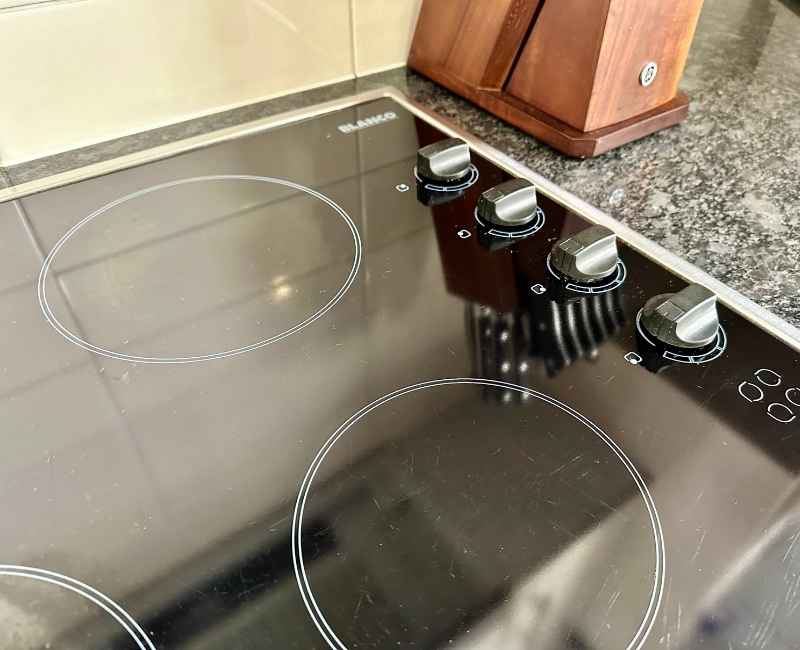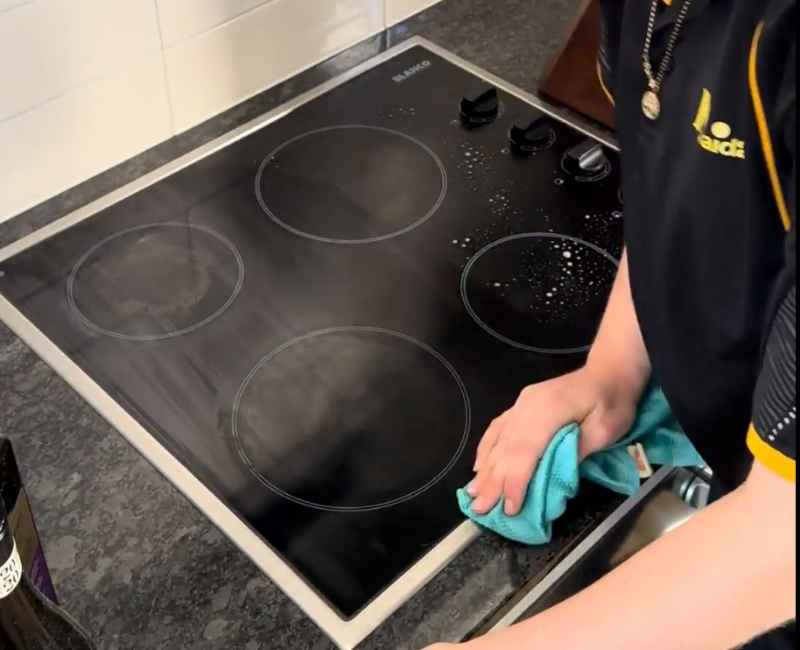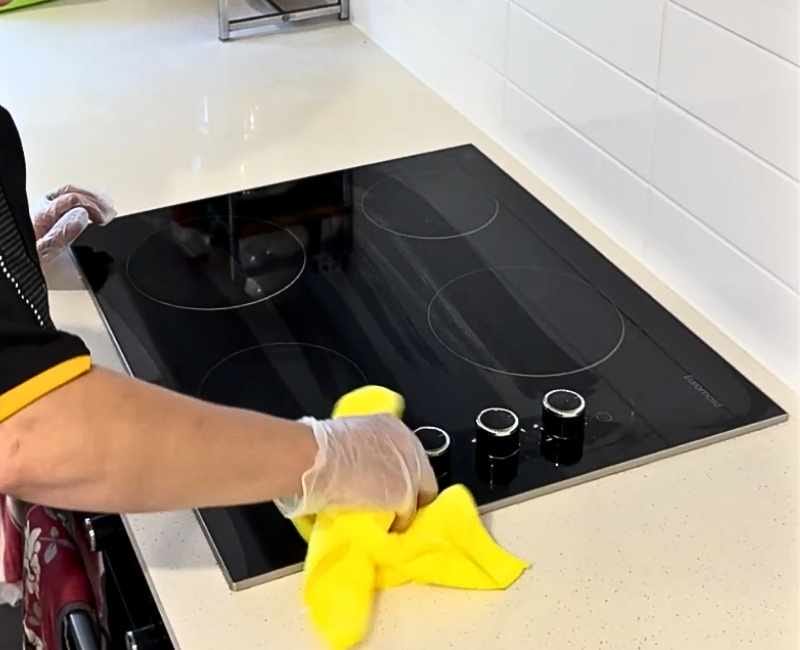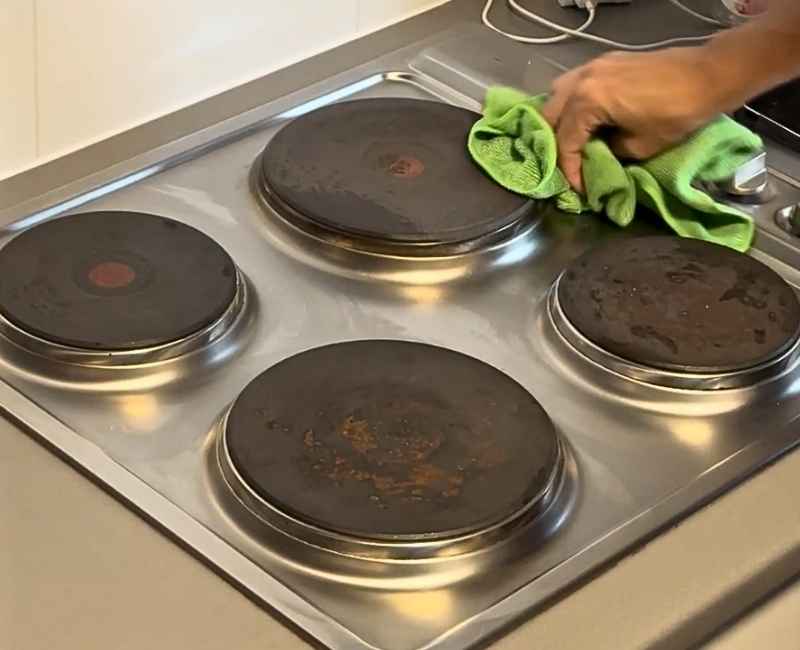Many homeowners are making the switch to an electric stove top, for a variety of reasons. They’re convenient and easy to use, plus less risk since there’s no gas.
Of course, owning one means you’ll need to know how to clean an electric stove top – but that’s thankfully straightforward!
The best cleaning methods include:
Note that if your model has removable coil burners, you’ll need to clean those as well. Don’t forget the knobs, drip pans, and exterior either.
Keeping your stove clean means a more hygienic surface for cooking – and ensures the area doesn’t look like a mess. Just make sure to keep the rest of your kitchen clean, too!
What is an Electric Stove Top?

Just as the name says – an electric stove uses electricity to heat up (and glow red). They may also be called radiant cooktops.
Ceramic and glass stove tops are both types of surface “covers” for the burners on an electric stove.
The electrical current flows through a metal coil, which is either exposed in a recessed cavity or covered by a glass surface. The coil then transfers the heat to the pot to cook your food.
There are three main types of electric cooktops:
- Traditional coil burners have the coils exposed in a recessed cavity on the stove top. The cavity will also act as the drip pan.
- A glass cooktop or “smooth” top stove has a smooth, glass surface that covers the burners. The heat is transferred through the glass stovetop using infrared energy.
- A ceramic cooktop is less common since it’s less energy-efficient and warms up much slower, although it can be cheaper. In terms of cleaning, you can use the same methods as a glass top.
Traditional exposed coils may heat unevenly, but can allow you to cook using pots of various sizes. On the other hand, glass tops transfer heat more quickly and evenly, but can get scratched or “burned.”
You can also get additional elements such as dual coils (for cooking with smaller pots) or bridges (for cooking on long cookware like griddles).
Electric vs. Induction Stove Tops

Induction cookers also run on electricity, so they are technically a type of electric cooktop. However, the way they heat cookware and food is different from the “typical” electric stove.
With an electric stove, the burner heats up due to the electrical current and transfers heat via infrared energy to the cookware. The burner gets hot, and that heats up the pan.
On the other hand, induction cookers use electromagnetic radiation to heat cookware. The heating is more instantaneous and there’s much less energy escape, as the radiation heats the pan directly.
The advantages of an electric cooktop are versatility, lower cost, and ease of use. However, the residual heat on the burners can be hazardous and they take longer to heat up/cool down.
For induction cooktops, they’re more energy-efficient and have no residual heat. They’re also easier to clean since the surface doesn’t heat up.
However, induction stove tops require special, compatible cookware – not all pots and pans are compatible. The electromagnetic radiation can also interfere with digital thermometers.
Before Cleaning an Electric Stove Top

Always let your electric stove cool down before cleaning. Check the indicator light – if it’s still lit, your stove is too hot to clean.
You can also try placing a drop of water on the surface. If it sizzles, wait a bit longer.
Ensure all the knobs are turned to OFF and unplug the cooktop if you’re able to minimise risks.
If you have an electric stove top with coil burners, remove the burners and drip pans to clean separately.
When the cooktop is still warm but not hot, use a cooktop scraper at a 45º angle to remove any food residue. Wear an oven mitt (or similar protective glove) and work carefully.
Never substitute the cooktop scraper for abrasive cleaners like steel wool, since these will scratch or damage the cooking surface.
For wiping, opt for microfibre cloths or towels.
How Often to Clean an Electric Stove Top
Regular maintenance goes a long way to keeping your stove clean!
After cooking, quickly wipe down the electric cooktop with a cloth dampened in water and dish detergent. This will help prevent grease and other residue from building up on the surface.
Immediately clean any spills with a dry cloth. If the cooktop is cool, you can use some paper towels (gently!).
Once a week, deep clean your electric stove top – from the coils to the knobs. You may need to deep clean more frequently if you notice a build-up of grease or debris.
How to Clean Electric Stove Top

There are several ways to clean an electric stove top, but they’ll work whether you have coil burners or a glass stove top.
The only difference is cleaning the burners and drip pans separately for a traditional coil stove.
Pro tip – make the most of your cleaning time and tackle other areas of your kitchen while you’re at it. Or you could hire a professional house cleaner to tidy your whole kitchen for you!
Cleaning an electric stove top with dish soap
This is the easiest way to clean, especially if you’re just wiping down the cooktop surface after use.
Mix a few drops of anti-grease liquid dish soap into warm water. Dip a microfibre cloth into the soapy water and wring it out.
You can also apply dish soap directly to a dampened cloth or non-abrasive sponge.
Carefully wipe down the stove top, paying special attention to any greasy areas. Follow with a damp rag to rinse off any residue, then use a clean cloth to dry.
Cleaning an electric stove top with baking soda
Baking soda is a powerhouse cleaner, and it’s great for electric stoves since it’s only mildly abrasive (especially in a paste).
Mix 3 parts baking soda to 1 part warm water to form a thick paste. Use a non-abrasive sponge or cleaning pad to apply the mixture onto the cooktop.
(Try these Scotch Brite Cooktop Pads for scratch-free cleaning!)
Let the baking soda paste sit for about 5 minutes so it absorbs any grease or loosens any stubborn stains.
Take a damp cloth or non-abrasive sponge and use it to gently scrub the surface. Work in circular motions and don’t press too hard so you don’t leave any scratches.
Rinse the residue off with a fresh damp towel, then wipe the surface dry.
Cleaning an electric stove top with white vinegar
For tough stains or smudges, vinegar is a great way to clean an electric stove – especially one with a glass top.
Mix equal parts white vinegar and warm water in a spray bottle. Apply the mixture all over the cooktop, then let it sit for about 10 minutes.
Wipe the cooktop with a clean, dry cloth. Repeat if the stains or food residue remains.
You can also combine white vinegar with baking soda – just not at the same time. Start with the baking soda paste and gently scrub the stove top with a damp cloth or cleaning pad.
Once all the baking soda is gone, follow with the vinegar spray. Wipe the surface with a clean towel afterwards.
Cleaning an electric stove top with cooktop cleaner

There are cooktop cleaners specially formulated for electric stoves and glass stove tops.
The Cerama Bryte Combo Kit comes with a 10oz cleaner that works on all smooth cooktops, including electric ones! The kit also has a scratch-free scraper and cleaning pad.
Weiman also has a Cooktop and Stove Top Cleaner Kit that works on an electric stove top. The kit comes with a scraper and a scrubbing pad.
How to Clean Electric Stove Coil Burners
If your stove top comes with removable coil burners, you’ll need to clean those as well!
On the plus side, they’re somewhat self-cleaning. Start by removing everything from the stove and ensuring all surfaces are dry – you don’t want to risk a short-circuit or a fire.
Turn the burners on high for 2-3 minutes, until they’re red hot. This will burn off any food residue and other stuck-on debris.
Switch on your range hood to vent any smoke and keep both kids and pets away.
Once time is up, switch the stove off and let it completely cool down. Then remove the burners and brush off any ash or debris using a dry cloth or some paper towels.
(Take the drip pans or burner bowls out too!)
Add a little dish soap to some hot water, then dip a microfibre cloth or soft sponge into the mixture. Wring it out so it’s just damp.
Use the soapy sponge or cloth to scrub the burners clean, then wipe them completely dry.
Unless the user manual says otherwise, never soak the burners in water or place them in the dishwasher. The water can get into the electric components, which risks short-circuiting your stove top and starting a fire.
Cleaning Other Parts of Electric Stoves
Besides the stove top and burners, you’ll need to clean the rest of your electric cooktop to keep everything in working order.
Cleaning electric stove drip pans
The drip pans (also called drip trays or burner bowls) sit underneath the coils to catch any crumbs, spills, and other debris. They’re usually the parts that get the most dirty.
Once you’ve removed the pans, throw any loose food debris into the rubbish bin.
Fill your sink or a small tub with warm water and dish soap – enough to submerge the drip pans. You can add a cup of vinegar for added cleaning power.
Let the pans soak for 15-20 minutes, then scrub them with a sponge or cleaning pad. For stuck-on food or stubborn stains, use the baking soda paste.
Rinse the drip pans with hot water, then thoroughly dry with a clean towel.
Cleaning electric stove knobs

Check the manual if you can remove the cooktop knobs or not.
If yes, you can unscrew them and give them a quick wash in your sink using dish soap and water. Do not remove any seals. Dry them thoroughly before putting them back.
If the knobs are not removable, simply spray them with the vinegar and water mixture. Let the solution sit for a minute or two, then wipe the knobs dry with a clean cloth.
Be thorough and get into all the spaces so you don’t miss any dirt!
Cleaning under the cooktop
Check your owner’s manual to see if you can lift up the cooktop surface.
If yes, lift the front corners of the cooktop until the support locks click into place. Follow the instructions in the manual if you’re unsure.
Clean the area with a soft cloth dampened with water and dish soap. Use a fresh cloth to wipe away any residue and thoroughly dry all surfaces.
Close the cooktop carefully.
Cleaning the stove exterior
Finish up by cleaning the exterior of your stove top. Your cleaning method will depend on the material – many electric stove tops use stainless steel, but some may have special coatings.
You can clean stainless steel using a mix of vinegar and water. Use soft microfibre cloths to avoid leaving smudges or spotting.
Dry the exterior thoroughly.
For other materials, check your owner’s manual to see what you can use for cleaning.
FAQs About Cleaning Electric Stove Tops
Have more questions about how to clean electric stove tops? Here are answers to some common queries and issues.
Can you use vinegar on an electric stove top?
Yes, vinegar is safe to use on an electric stove – it’s actually very effective if you have one with a glass top!
How do you get burnt residue off an electric stove top?

If you’ve got food spills like burnt milk on your stove top, don’t panic.
First, try using a cooktop scraper to remove as much residue as you can while the stove is warm – not hot. Keep the scraper at an angle so you don’t scratch anything.
If that doesn’t work, wait until the cooktop has cooled. Make a paste out of baking soda, water, and a bit of dish detergent and apply it to the affected area.
Let the solution sit for 5-10 minutes to loosen the burnt residue. Then go back with the cooktop scraper to clean the cooktop.
Lastly, vinegar can help loosen burnt residue as well. Lightly spritz the affected area and wait a few minutes before scraping the residue off.
Once clean, rinse the cooktop with a damp cloth.
How do you remove melted plastic from an electric stove top?
Melted plastic can make a mess on many surfaces, including your electric stove. That’s why you should only use appropriate tools when cleaning the stove – a plastic scraper could melt from residual heat.
Open all windows and switch on any exhaust fans or range hoods to vent any fumes. Immediately switch off the cooktop. You can wear a face mask as well.
Once the stove has completely cooled, use a cooktop scraper or dull knife to remove as much plastic residue as possible. Check the drip pan as well.
Switch on the burner to the lowest possible setting to carefully warm the plastic. While wearing an oven glove, use a wooden spatula or spoon to scrape away the plastic.
Wipe the melted material on a paper towel as you work.
Once you’ve gotten as much plastic off as possible, switch the burner on high for no longer than 2 minutes. This will burn away the remaining plastic residue.
Keep the windows open and the exhaust on until all the fumes have gone away.
How do you get burn marks off an electric stove?
Burn marks on an electric stovetop or glass top usually happen if something boils over or you spill some hot food.
If you don’t get the spill right away, the heat can “bake” it into the stove top, making it harder to remove.
The easiest way to get burn marks off an electric stove is by using baking soda. Mix about 3 tbsp of water into a half cup of baking soda, then apply the paste to the marks.
Let it sit for a few minutes, then use a cooktop scraper to carefully work at the burn residue so it flakes off. Use gentle motions and keep the scraper angled to prevent scratches.
If the burn marks don’t come off on the first go, reapply the paste. After a few minutes, spritz it with a bit of vinegar, then go back with the scraper.
Wipe the cooktop clean with a damp microfibre cloth.
How to fix scratches on an electric stove top?
Note that DIY solutions will only work on minor scratches on a glass stove top. Large cracks may need professional work or full replacement.
You can try buffing the scratch away with a baking soda paste or white toothpaste (not a gel formula). Use a soft cloth and gentle motions.
If that doesn’t work – you’ll either need to bring in a pro, or simply live with the scuff marks.
How do you degrease an electric stove?
Baking soda is great at absorbing grease on many surfaces!
One method involves mixing it with water and dish detergent to form a paste – dry baking soda can be too abrasive. Use a damp cloth to apply the paste onto the greasy area and gently scrub.
Alternatively, sprinkle baking soda onto the greasy spot then cover it with a damp cloth.
Wipe away any residue with a fresh, damp microfibre cloth then dry the stove top.
TIP: You can use cornstarch as an alternative – it’s also great at absorbing grease!
Can you use glass cleaner on a glass stove top?
No, you cannot use commercial glass cleaner on the glass top of your electric stove.
Most glass cleaning products contain ammonia or similarly harsh chemicals that can damage your stove top. The products could also leave a residue that poses a fire risk.

